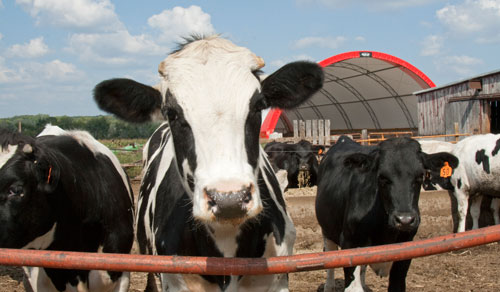
by Amanda Smith, Associate Editor
The prices received at market for Holstein bull calves have been remarkably high as of late. While many dairymen have taken advantage of the recent price hike, others have chosen to retain their steers and sell them later on. At the Vita Plus Dairy Summit, Ty Lawrence, with West Texas A&M University, spoke on the optimal market end point when feeding Holstein steers.
"We will be feeding bigger Holsteins in the future," noted Lawrence. It's well known that when compared to their beef breed counterparts, Holstein steers have a reduced daily gain and gain-to-feed ratio. The research conducted by Lawrence's group attempted to establish the best time to harvest steers and maximize performance.
Steers (135 total) were selected at 180 days on feed and subsequently harvested between 254 and 534 days on feed. At the beginning of the trial, steers had a dry matter intake of 19.5 pounds per day. Intake peaked between 360 and 392 days on feed (24.7 pounds). After this point, intake gradually declined, as did feed efficiency.
In June of last year, Tyson Foods issued a rule that cattle going through its plants could stand no more than 58 inches at the hip. Hip height has become a contemporary issue as Holstein steers continue to increase in skeletal height. This has occurred as dairymen have selected for frame size and milk yield.
When a steer has reached 1,250 pounds, there is a 10 percent chance it will be above 58 inches at the hip; this rises to 20 percent once the steer reaches 1,325 pounds. In accordance with this, slaughterhouses have seen more loin, sirloin and back bruises as taller cattle scrape the top of the trailer.
The first animals harvested at 254 days on feed had an empty body weight (hundredweight) of 1,011 pounds. Steers harvested at the end of the trial had reached 1,722 pounds. Unlike a beef breed, a Holstein does not deposit fat quickly. The carcasses improved a yield grade unit for every 125 days the cattle were on feed. For marbling scores, an additional 166 days on feed were required to go from USDA Select to USDA Choice.
Lawrence concluded that 394 days on feed was the clear winner to maximize revenue today. At this point, the risk of sending lightweight carcasses is lower, and most carcasses will have moved from Select to Choice. Furthermore, there will be fewer heavyweight and Yield Grade 4 discounts.








